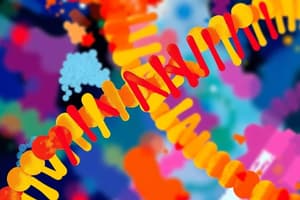Podcast
Questions and Answers
What is the main difference between prokaryotic and eukaryotic DNA?
What is the main difference between prokaryotic and eukaryotic DNA?
- The presence of continuous coding regions (correct)
- The type of nucleotides
- The size of the genome
- The number of chromosomes
What are the non-coding regions in eukaryotic DNA called?
What are the non-coding regions in eukaryotic DNA called?
- Exons
- Nucleotides
- Introns (correct)
- Chromosomes
What are the coding regions in eukaryotic DNA called?
What are the coding regions in eukaryotic DNA called?
- Nucleotides
- Introns
- Chromosomes
- Exons (correct)
What is characteristic of prokaryotic DNA?
What is characteristic of prokaryotic DNA?
What is the main difference between prokaryotic and eukaryotic gene structure?
What is the main difference between prokaryotic and eukaryotic gene structure?
Which of the following is true about eukaryotic DNA?
Which of the following is true about eukaryotic DNA?
What is the term for the coding regions in eukaryotic DNA?
What is the term for the coding regions in eukaryotic DNA?
What is characteristic of eukaryotic DNA?
What is characteristic of eukaryotic DNA?
Which of the following is NOT a characteristic of prokaryotic DNA?
Which of the following is NOT a characteristic of prokaryotic DNA?
What is the main difference between prokaryotic and eukaryotic gene organization?
What is the main difference between prokaryotic and eukaryotic gene organization?
Flashcards are hidden until you start studying
Study Notes
Here are the study notes:
Gene Transcription and mRNA
- Gene transcription is the process by which information in a gene's DNA is copied into a complementary RNA molecule.
- This process is necessary for the creation of proteins, as proteins are synthesized based on the information in mRNA molecules.
- In this process, a specific enzyme called RNA polymerase reads the template DNA strand and adds nucleotides to a growing RNA chain.
Types of RNA
- There are several types of RNA, including:
- mRNA (messenger RNA): carries genetic information from DNA to the ribosome for protein synthesis
- tRNA (transfer RNA): brings amino acids to the ribosome to be incorporated into proteins
- rRNA (ribosomal RNA): makes up a large part of the ribosome, which is responsible for protein synthesis
Central Dogma
- The central dogma is the process by which genetic information flows from DNA to proteins:
- Replication: DNA is copied into DNA
- Transcription: DNA is copied into RNA
- Translation: RNA is translated into protein
- This flow of information is often depicted as: + DNA → RNA (transcription) + RNA → Protein (translation)
Genetic Engineering
- Genetic engineering is the direct manipulation of an organism's genome using biotechnology.
- It involves the use of recombinant DNA technology, which allows scientists to manipulate genetic information in the laboratory.
- This can be used to introduce new traits into an organism, such as antibiotic resistance or the ability to produce a specific protein.
Applications of Genetic Engineering
- Genetic engineering has many applications, including:
- Medical applications: production of insulin, human growth hormone, and other therapeutic proteins
- Agricultural applications: creation of pest-resistant crops, development of new crops with improved yield or nutritional content
- Industrial applications: production of biofuels, bioproducts, and other industrial chemicals
Structure of DNA
- DNA is a double-stranded molecule, with two complementary strands that are twisted together in a double helix structure.
- Each strand is composed of nucleotides, which are linked together by hydrogen bonds between the sugar and phosphate molecules.
- The sequence of nucleotides determines the genetic information encoded in the DNA.
RNA Structure
- RNA is a single-stranded molecule, composed of nucleotides linked together by hydrogen bonds between the sugar and phosphate molecules.
- RNA can form complex secondary and tertiary structures, including stem-loops, pseudoknots, and riboswitches.
History of Genetic Engineering
- The discovery of DNA structure by Watson and Crick in 1953 marked the beginning of the era of genetic engineering.
- The development of recombinant DNA technology in the 1970s and 1980s enabled the manipulation of genetic information in the laboratory.
- Since then, genetic engineering has become a powerful tool for understanding and manipulating genetic information in organisms.
Ethical Considerations
- Genetic engineering raises several ethical considerations, including:
- Concerns about the safety of genetically modified organisms (GMOs)
- Questions about the potential for genetic engineering to exacerbate existing social inequalities
- Debates about the moral implications of manipulating genetic information in humans and other organisms.
Studying That Suits You
Use AI to generate personalized quizzes and flashcards to suit your learning preferences.




